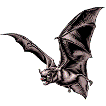Museum, University of Nebraska State

University of Nebraska State Museum: Mammalogy Papers
Document Type
Article
Date of this Version
1980
Abstract
The sound made by adult male American bison (Bison bison) during agonistic behavior has been described as a "roar" because of its similarity to the roar of an African lion (Shult, 1972). Bulls roar any time of the year, but more commonly and most intensively during the rut when there are many agonistic confrontations between competing males. McHugh (1958), Shult (1972), and Petersburg (1973) have described this roaring and under what circumstances it occurs.
While the bull is roaring, its tongue is protruded and the sound is produced by forceful expiration of air over the vocal cords. In contrast, the "mooing" and loud "bawling" or "bellowing" of domestic cows and bulls (Bos taurus) are produced by both expiration and inspiration of air over the vocal cords (Kelemen, 1963).
The basic sound made by bison is a grunt. This varies from the barely audible vocalization of young calves to the loud roaring of the bulls. Although more common among bison bulls, cows protecting their newborn calves also roar (Mahan, 1978), but not as loudly as bulls. Sounds usually made by bison cows consist of soft gutteral grunts. Calves produce higher pitched grunts, often in response to their dam's somewhat louder grunting. Calves also bleat loudly, usually during active chases and play fights with other calves. Grunting occurs at all times of the year, but more frequently when the calves are very young and again when the calves begin leaving the cow and forming subgroups within the herd. McHugh (1958) discussed the function and occurrence of the sounds made by bison cows and calves. In general, their vocalizations are comparable in sound and function to that of domestic cows and calves.


Comments
Gunderson & Mahan in Journal of Mammalgy (May 1980) 61(2). Copyright 1980, American Society of Mammalogists. Used by permission.